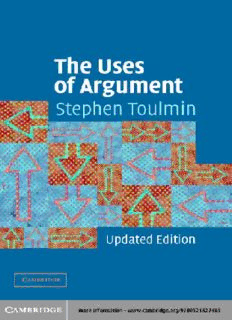
The Uses of Argument PDF
Preview The Uses of Argument
This page intentionally left blank TheUsesofArgument,UpdatedEdition ‘A central theme throughout the impressive series of philosophical booksandarticlesStephenToulminhaspublishedsince1948isthe way in which assertions and opinions concerning all sorts of topics, broughtupineverydaylifeorinacademicresearch,canberationally justified.Isthereoneuniversalsystemofnorms,bywhichallsortsof argumentsinallsortsoffieldsmustbejudged,ormusteachsortof argumentbejudgedaccordingtoitsownnorms? ‘InTheUsesofArgument(1958)Toulminsetsouthisviewsonthese questions for the first time. Reacting severely against the “narrow” approach to ordinary arguments taken in syllogistic and modern logic,headvocates—analogouswithexistingpracticeinthefieldof law—a procedural rather than formal notion of validity. According toToulmin,certainconstant(“field-invariant”)elementscanbedis- cerned in the way in which argumentation develops, while in every case there will also be some variable (“field-dependent”) elements inthewayinwhichitistobejudged.Toulmin’s“broader”approach aimsatcreatingamoreepistemologicalandempiricallogicthattakes bothtypesofelementsintoaccount. ‘Inspiteofinitialcriticismsfromlogiciansandfellowphilosophers, TheUsesofArgumenthasbeenanenduringsourceofinspirationand discussiontostudentsofargumentationfromallkindsofdisciplinary backgroundsformorethanfortyyears.NotonlyToulmin’sviewson the field-dependency of validity criteria but also his model of the “layout arguments”, with its description of the functional moves in theargumentationprocess,havemadethisbookamodernclassicin thestudyofargumentation.’ FransvanEemeren,UniversityofAmsterdam The Uses of Argument Updated Edition STEPHEN E. TOULMIN UniversityofSouthernCalifornia Cambridge, New York, Melbourne, Madrid, Cape Town, Singapore, São Paulo Cambridge University Press The Edinburgh Building, Cambridge , United Kingdom Published in the United States of America by Cambridge University Press, New York www.cambridge.org Information on this title: www.cambridge.org/9780521827485 © Stephen E. Toulmin 2003 This book is in copyright. Subject to statutory exception and to the provision of relevant collective licensing agreements, no reproduction of any part may take place without the written permission of Cambridge University Press. First published in print format 2003 - isbn-13 978-0-511-07117-1 eBook (EBL) - isbn-10 0-511-07117-5 eBook (EBL) - isbn-13 978-0-521-82748-5 hardback - isbn-10 0-521-82748-5 hardback isbn--13 978-0-521-53483-3 paperback - isbn-10 0-521-53483-6 paperback Cambridge University Press has no responsibility for the persistence or accuracy of s for external or third-party internet websites referred to in this book, and does not guarantee that any content on such websites is, or will remain, accurate or appropriate. © Cambridge University Press 1958 © Stephen E. Toulmin 2003 First published 1958 First paperback edition 1964 Updated edition first published 2003 Contents PrefacetotheUpdatedEdition pagevii PrefacetothePaperbackEdition xi PrefacetotheFirstEdition xiii Introduction 1 I. FieldsofArgumentandModals 11 ThePhasesofanArgument 15 ImpossibilitiesandImproprieties 21 ForceandCriteria 28 TheField-DependenceofOurStandards 33 QuestionsfortheAgenda 36 II. Probability 41 IKnow,IPromise,Probably 44 ‘ImprobableButTrue’ 49 ImproperClaimsandMistakenClaims 53 TheLabyrinthofProbability 57 ProbabilityandExpectation 61 Probability-RelationsandProbabilification 66 IstheWord‘Probability’Ambiguous? 69 Probability-TheoryandPsychology 77 TheDevelopmentofOurProbability-Concepts 82 III. TheLayoutofArguments 87 ThePatternofanArgument:DataandWarrants 89 ThePatternofanArgument:BackingOurWarrants 95 AmbiguitiesintheSyllogism 100 TheNotionof‘UniversalPremisses’ 105 TheNotionofFormalValidity 110 v vi Contents AnalyticandSubstantialArguments 114 ThePeculiaritiesofAnalyticArguments 118 SomeCrucialDistinctions 125 ThePerilsofSimplicity 131 IV. WorkingLogicandIdealisedLogic 135 AnHypothesisandItsConsequences 136 TheVerificationofThisHypothesis 143 TheIrrelevanceofAnalyticCriteria 153 LogicalModalities 156 LogicasaSystemofEternalTruths 163 System-BuildingandSystematicNecessity 174 V. TheOriginsofEpistemologicalTheory 195 FurtherConsequencesofOurHypothesis 201 CanSubstantialArgumentsbeRedeemed?I:Transcendentalism 206 CanSubstantialArgumentsbeRedeemed?II:Phenomenalism andScepticism 211 SubstantialArgumentsDoNotNeedRedeeming 214 TheJustificationofInduction 217 IntuitionandtheMechanismofCognition 221 TheIrrelevanceoftheAnalyticIdeal 228 Conclusion 233 References 239 Index 241 Preface to the Updated Edition Booksarelikechildren.Theyleavehome,makenewfriends,butrarely callhome,evencollect.Youfindoutwhattheyhavebeenuptoonlyby chance. A man at a party turns out to be one of those new friends. ‘So youareGeorge’sfather?–Imaginethat!’ SohasbeentherelationbetweenTheUsesofArgumentanditsauthor. When I wrote it, my aim was strictly philosophical: to criticize the as- sumption, made by most Anglo-American academic philosophers, that anysignificantargumentcanbeputinformalterms:notjustasasyllogism, since for Aristotle himself any inference can be called a ‘syllogism’ or ‘linkingofstatements’,butarigidlydemonstrativedeductionofthekind tobefoundinEuclideangeometry.ThuswascreatedthePlatonictradi- tionthat,sometwomillennialater,wasrevivedbyRene´Descartes.Readers ofCosmopolis,ormymorerecentReturntoReason,willbefamiliarwiththis generalviewofmine. InnowayhadIsetouttoexpoundatheoryofrhetoricorargumenta- tion:myconcernwaswithtwentieth-centuryepistemology,notinformal logic.StilllesshadIinmindananalyticalmodellikethatwhich,among scholars of Communication, came to be called ‘the Toulmin model’. Many readers in fact gave me an historical background that consigned metoaprematuredeath.Whenmyfiance´ewasreadingLaw,forinstance, afellow-studentremarkedonherunusualsurname:hisgirlfriend[heex- plained]hadcomeacrossitinoneofhertextbooks,butwhenhereported thatDonnawasmarryingtheauthor,shereplied,‘That’simpossible:He’s dead!’ vii viii PrefacetotheUpdatedEdition My reaction to being (so to say) ‘adopted’ by the Communication Communitywas,Iconfess,lessinquisitivethanitshouldhavebeen.Even the fact that the late Gilbert Ryle gave the book to Otto Bird to review, and Dr Bird wrote of it as being a “revival of the Topics” made no im- pression on me. Only when I started working in Medical Ethics, and I reread Aristotle with greater understanding, did the point of this com- mentarysinkin.(Thebook,TheAbuseofCasuistry,thescholarlyresearch for which was largely the work of my fellow-author, Albert R. Jonsen, was the first solid product of that change of mind.) Taking all things together, our collaboration, first on the National Commission for the ProtectionofHumanResearchSubjects,andsubsequentlyonthebook, leftuswithapictureofAristotleasmoreofapragmatist,andlessofafor- malist,thanhistoriansofthoughthavetendedtoassumesincetheHigh MiddleAges. True, the earliest books of Aristotle’s Organon are still known as the Prior and Posterior Analytics; but this was, of course, intended to contrast them with the later books on Ethics, Politics, Aesthetics, and Rhetoric. (The opening of the Rhetoric in fact takes up arguments that Aristotle had included in the Nicomachean Ethics.) So, after all, Otto Bird had made an important point. If I were rewriting this book today, I would point to Aristotle’s contrast between ‘general’ and ‘special’ topics as a way of throwing clearer light on the varied kinds of ‘backing’ relied on indifferentfieldsofpracticeandargument. It was, in the event, to my great advantage that The Uses of Argument found a way so quickly into the world of Speech Communication. The rightlynamed‘analytical’philosophersintheBritainandAmericaofthe late1950squicklysmelledanenemy.Thebookwasroundlydamnedby PeterStrawsonintheB.B.C.’sweeklyjournal,TheListener;andformany years English professional philosophers ignored it. Peter Alexander, a colleagueatLeeds,calledit‘Toulmin’santi-logicbook’;andmyDoktorvater atCambridge,RichardBraithwaite,wasdeeplypainedtoseeoneofhis ownstudentsattackinghiscommitmenttoInductiveLogic.(Ionlyfound thisoutyearslater.) Yetthebookcontinuedtosellabroad,andthereasonsbecameclear tomeonlywhenIvisitedtheUnitedStatesintheearly1960s.Asaresult, itwouldbechurlishofmetodisownthenotionof‘theToulminmodel’, which was one of the unforeseen by-products of The Uses of Argument, has kept it in print since it first appeared in 1958, and justifies the new edition for which this Preface is written, more than 40 years on.
Description: